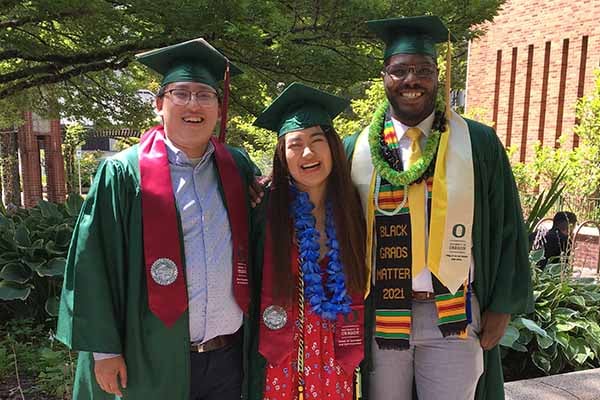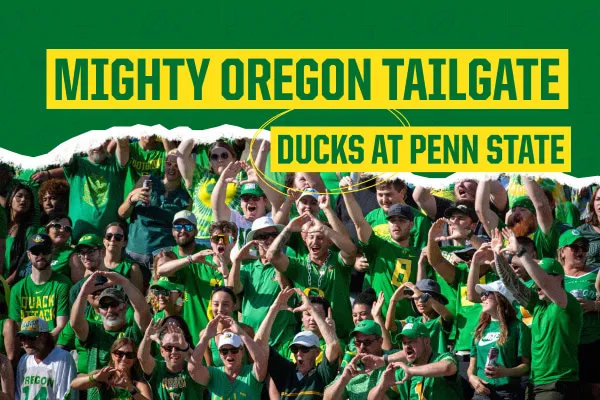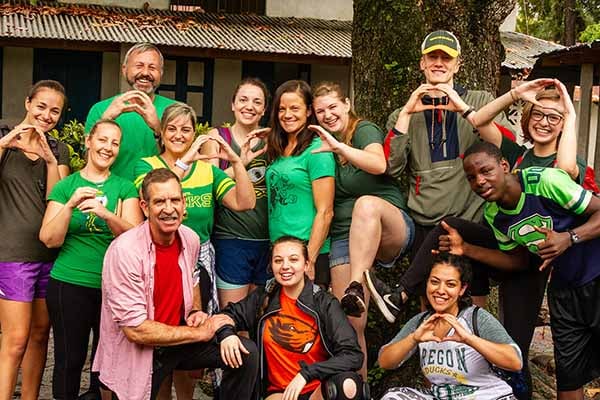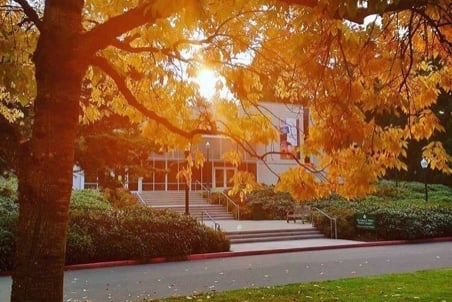UO History 101: Women on Campus
Since the University of Oregon’s first class of students in 1876, the women of UO have played a crucial part in the university’s scholarship and success. Learn more about a few of their milestones over the decades.

1876:
The University of Oregon first opened its doors in 1876, and University Hall was the academic hub of campus. There were two entrances to the building, the men’s entrance on the west side and the women’s entrance on the east side, which had shallower steps so that the women's ankles weren’t exposed as they walked up the steps.

1896:
Anna E. Wood became the first woman to graduate from the UO Law School, earning her bachelor of law degree.

Oregon Digital
1910s-1920s:
Made up of Gerlinger Hall, Hendricks Hall, and Susan Campbell Hall, the Women’s Quad was built to accommodate women living on campus. Hendricks and Susan Campbell Hall were the first major women’s residence halls on campus, and Gerlinger housed the Department of Physical Training for Women. Tennis courts were located on the Women’s Quad. However, women on campus weren’t allowed to play basketball because campus leaders found the sport to be “rough and unladylike.”
1932:

Franklin's senior photo / Oregana 1932
Nellie Louise Franklin became the first African American woman to graduate from the UO. Franklin grew up in Portland, attended Washington High School, and attended the University of Oregon, where she majored in music. While at the UO, Franklin faced housing discrimination and was denied residence in campus dorms. Despite this, she continued her studies and was involved in many organizations including the Women’s Athletic Association, the Polyphonic Choir, and the Cosmopolitan Club. She graduated on June 25, 1932, with her bachelor’s degree in music.
1949:
Carson Hall, named after Luella Clay Carson, was opened. Carson was a professor of English and elocution (1888–1909) and the dean of women (1895–1909). Shortly after Carson Hall had been named in her honor, a 1953 edition of the Register-Guard stated that “To Miss Carson we owe many of the traditions and organizations on campus, one being the State Association of University of Oregon Women.”
When it was built, Carson Hall was known as one of the up-to-date women’s dorms on college campuses; Carson had an all-electric kitchen, increased sanitation standards, a butcher shop and bakery in the basement, dishwashing facilities, and a conveyor belt for dirty dishes from the dining room.
1970s:
“The Status of Women at the University of Oregon” report was released in 1970 and set forth a decade of change for women at the UO. The study found that only 10.5% of the full-time teaching faculty at the UO were women and only 2.39% of the highest-ranking faculty were women. The following year, federal audits found the UO guilty of discriminatory policies against women. UO students organized the University Feminists, which advocated for women’s services and the institutionalization of women’s studies on campus. Their efforts helped secure gynecological services at the student health center.
In 1972, the first Introduction to Women’s Studies course was taught at the UO, and in 1973, more than thirty feminists took over the steps of Johnson Hall to demand immediate hiring of a full-time coordinator for a women’s studies department, funding for women’s studies faculty, childcare facilities for all university women, free access to continuing education for low-income women, increased access to women’s health care, and a campus women’s research center. Although many of these demands were not immediately met, the advocates’ actions paved the way for progress in the years to come.
A year later, the Center for the Sociological Study of Women was founded. Eight years later, they received the largest grant ever received by UO at that time from William Harris in memory of feminist Jane Grant, and the organization changed their name to Center for the Study of Women in Society to better reflect their mission to fund gender research on campus.
In 1979, the first campus Take Back the Night rally was organized, an event that has continued annually. Take Back the Night is a rally and march speaking out against sexual and domestic violence.
1988:
Four programs on campus, Project Safe Ride, the Women’s Resource and Referral Service, Women in Transition, and the Women’s Task Force join to establish the Women’s Center.
Located at the EMU, the Women’s Center is a safe and affirming environment for women and people of all gender identities.
1990s:
In 1990, the Center for the Study of Women in Society starts “A University for Everyone.” The two-year program aimed to implement scholarship on women of color into large social science and humanities survey classes. This was the first full-scale attempt to integrate materials on race and gender into these classes at the UO. Seven years later in 1997, the Oregon State Board of Education approved the women’s studies major at the UO.

1983 CSWS Founder’s Party, from left to right, Barbara Pope, Mavis Mate, Jean Stockard, Marilyn Farwell, Mary Rothbart, Joan Acker, Miriam Johnson, Jessie Bernard, Donald Van Houton, Carol Silverman, Kay McDade, and Patricia Gwartney-Gibbs / CSWS
2000s:
In 2006, Margaret “Margie” Paris became the first woman dean of Oregon Law. Three years later, the women’s studies program became the Department of Women’s, Gender, and Sexuality Studies at UO. The queer studies minor was also established, and the Sally Miller Gearhart Lecture Series was implemented to empower lesbian history and culture and promote dialogue about sexual orientation and gender identity in higher education.
2013:
In November 2013, the Center for Study of Women in Society, the Department of Women’s, Gender, and Sexuality Studies, and the ASUO Women’s Center celebrated 40 years of feminist research, teaching, and activism on the UO campus.
2023:
In Winter 2023, the Museum of Natural and Cultural History opened the Outliers and Outlaws exhibit, which features stories from the Eugene Lesbian History Project. The museum exhibit will be on display until the end of 2023.
In the 2023–2024 school year, the CSWS will be celebrating 50 years of research with exhibits, panels, marquis speakers, symposia, workshops, and more!
-By Peyton Hall, UO Alumni Association Student Associate
Related Articles:
Women in Sports: Title IX Anniversary
Breaking Barriers: Women in Government
Breaking Barriers: Women in Business Leadership
New UO museum exhibit focuses on local lesbian history
The UO celebrates 40 years of gender studies at the University of Oregon in the growing department of Women's and Gender Studies








